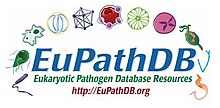Eukaryotic Pathogen Database
 From Wikipedia - Reading time: 3 min
From Wikipedia - Reading time: 3 min

The Eukaryotic Pathogen Vector and Host Database, or VEuPathDB, is a database of genomics and experimental data related to various eukaryotic pathogens. It was established in 2006 under a National Institutes of Health program to create Bioinformatics Resource Centers to facilitate research on pathogens that may pose biodefense threats.[citation needed] VEuPathDB stores data related to its organisms of interest and provides tools for searching through and analyzing the data. It currently consists of 14 component databases, each dedicated to a certain research topic. VEuPathDB includes:[citation needed]
- Genomics resources covering eukaryotic protozoan parasites
- Host responses to parasite infection (HostDB)
- Orthologs (OrthoMCL)
- Clinical study data (ClinEpiDB)
- Microbiome data (MicrobiomeDB)
History
[edit]VEuPathDB was established under the NIH Bioinformatics Resource Centers program as ApiDB, a resource meant to cover Apicomplexan parasites.[1] ApiDB originally consisted of component sites CryptoDB (for Cryptosporidium), PlasmoDB (for Plasmodium), and ToxoDB (for Toxoplasma gondii).[2] As ApiDB grew to focus on eukaryotic pathogens beyond Apicomplexans, the name was changed to EuPathDB to support its broadened scope.[3] EuPathDB was the result of collaboration between many different parasitologists, including David Roos, Jessica Kissinger and Dyann Wirth.[4][5] VEuPathDB provides public access to computational platforms and analysis tools enabling the collection, management, integration, and mining of genomic information and other large-scale datasets relevant to infectious disease pathogens, including their interaction with mammalian hosts and invertebrate vectors of disease.
Functions
[edit]It is an integrated database covering the eukaryotic pathogens in several genera as well as hosts and vectors of these organisms. It enables the accessing of detailed genome information associated with these pathogens. VEuPathDB was formerly known as ApiDB and was the integrated resources for the apicomplexans covering the databases of associated pathogens, ToxoDB, PiroplasmDB and CryptoDB.[2]
VEuPathDB is noted for its sophisticated search strategy system and comprehensive gene pages, providing invaluable help to researchers.[3]
Component databases
[edit]EuPathDB consists of 14 component databases, each with a particular focus:[6]
- AmoebaDB (Pathogenic amoeba)
- CryptoDB (Cryptosporidium species)
- FungiDB (Pathogenic fungi)
- GiardiaDB (Giardia species)
- MicrosporidiaDB (Microsporidia species)
- PiroplasmaDB (Pathogenic Piroplasmida)
- PlasmoDB (Plasmodium species)
- ToxoDB (Toxoplasma gondii)
- TrichDB (Trichomonas species)
- TriTrypDB (Kinetoplastida such as Leishmania and Trypanosoma species)
- HostDB (host response to parasite infection)
- OrthoMCL (for orthologous protein sequences)
- ClinEpiDB (for clinical study data)
- MicrobiomeDB (for microbiome data)
References
[edit]- ^ Greene JM, Collins F, Lefkowitz EJ, Roos D, Scheuermann RH, Sobral B, Stevens R, White O, Francsco VD (2007). "National Institute of Allergy and Infectious Diseases Bioinformatics Resource Centers: New Assets for Pathogen Informatics". Infection and Immunity. 75 (7): 3212–3219. doi:10.1128/IAI.00105-07. PMC 1932942. PMID 17420237.
- ^ a b Aurrecoechea C, Heiges M, Wang H, Wang Z, Fischer S, Rhodes P, Miller J, Kraemer E, Stoeckert CJ Jr, Roos DS, Kissinger JC (2007). "ApiDB: integrated resources for the apicomplexan bioinformatics resource center". Nucleic Acids Res. 35 (Database issue): D427-30. doi:10.1093/nar/gkl880. PMC 1669770. PMID 17098930.
- ^ a b Aurrecoechea C, Brestelli J, Brunk BP, Fischer S, Gajria B, Gao X, Gingle A, Grant G, Harb OS, Heiges M, Innamorato F, Iodice J, Kissinger JC, Kraemer ET, Li W, Miller JA, Nayak V, Pennington C, Pinney DF, Roos DS, Ross C, Srinivasamoorthy G, Stoeckert CJ Jr, Thibodeau R, Treatman C, Wang H (2010). "EuPathDB: a portal to eukaryotic pathogen databases". Nucleic Acids Res. 38 (Database issue): D415-9. doi:10.1093/nar/gkp941. PMC 2808945. PMID 19914931.
- ^ "Parasitologist, Reprogrammed: A Profile of David Roos". The Scientist Magazine®. Retrieved 2019-08-02.
- ^ "EuPathDB : About All". eupathdb.org. Retrieved 2019-08-02.
- ^ "The Eukaryotic Pathogen genome resource". EuPathDB. Retrieved 2013-11-11.
 KSF
KSF